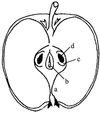Attachment of Escherichia coli O157:H7 to the surfaces and internal structures of apples as detected by confocal scanning laser microscopy
- PMID: 11055910
- PMCID: PMC92366
- DOI: 10.1128/AEM.66.11.4679-4687.2000
Attachment of Escherichia coli O157:H7 to the surfaces and internal structures of apples as detected by confocal scanning laser microscopy
Abstract
Confocal scanning laser microscopy (CSLM) was used to demonstrate the attachment of Escherichia coli O157:H7 transformed with a plasmid encoding for green fluorescent protein (GFP) to the surface and within the internal structures of nonwaxed Red Delicious cv. apples. Apples at 2 or 25 degrees C were inoculated with an E. coli O157:H7 cell suspension at 2 or 25 degrees C. The effect of a negative temperature differential (cold inoculum, warm apple), a positive differential (warm inoculum, cold apple), and no differential (warm inoculum, warm apple), in combination with a pressure differential (atmospheric versus 10,130 Pa), on the attachment and infiltration of cells was determined. CSLM stereo images of external surfaces of apples subjected to all combinations of test parameters showed preferential cellular attachment to discontinuities in the waxy cuticle on the surface and to damaged tissue surrounding puncture wounds, where the pathogen was observed at depths up to 70 microm below the skin surface. Attachment to lenticels was sporadic but was occasionally observed at depths of up to 40 microm. Infiltration through the floral tube and attachment to seeds, cartilaginous pericarp, and internal trichomes were observed in all apples examined, regardless of temperature differential during inoculation. The pressure differential had no effect on infiltration or attachment of E. coli O157:H7. Image analysis to count cells at various depths within tissues was used to quantitatively compare the extent of infiltration into various apple structures as well as the effects of the temperature differential. Puncture wounds harbored greater numbers of the pathogen at greater depths than did other sites examined. Attachment or infiltration of cells was greater on the intact skin and in lenticels, russet areas, and the floral tube of apples inoculated under a negative temperature differential compared to those inoculated under no temperature differential. The results suggest that E. coli O157:H7 attached to internal core structures or within tissues of apples may evade decontamination treatments. Interventions designed to deliver disinfectants to these locations or to remove viable cells of E. coli O157:H7 and other pathogens from apples by other means need to be developed and validated.
Figures








References
-
- Adams M R, Hartley A D, Cox L J. Factors affecting the efficacy of washing procedures used in the production of prepared salads. Food Microbiol. 1989;6:69–77.
-
- Bartz J A. Infiltration of tomatoes immersed at different temperatures to different depths in suspensions of Erwinia carotovora subsp. carotovora. Plant Dis. 1982;66:302–305.
-
- Bartz J A, Showalter R K. Infiltration of tomatoes by aqueous bacterial suspensions. Phytopathology. 1981;71:515–518.
-
- Beuchat L R. Pathogenic microorganisms associated with fresh produce. J Food Prot. 1996;59:204–216. - PubMed
-
- Beuchat L R, Nail B V, Adler B B, Clavero M R S. Efficacy of spray application of chlorinated water in killing pathogenic bacteria on raw apples, tomatoes, and lettuce. J Food Prot. 1998;61:1305–1311. - PubMed
MeSH terms
LinkOut - more resources
Full Text Sources

